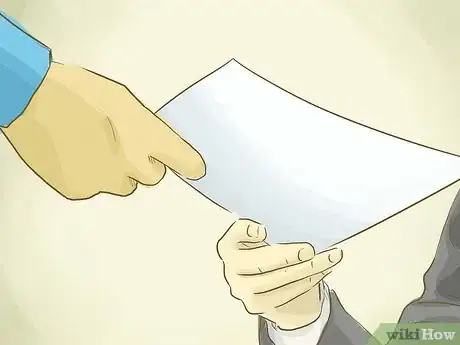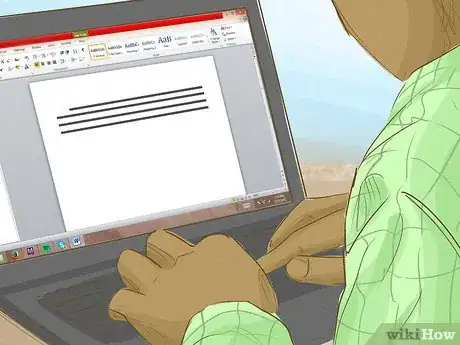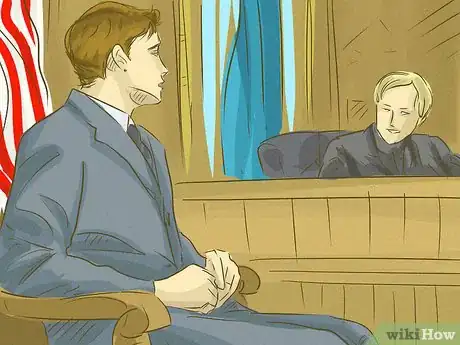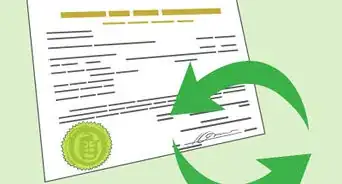This article was co-authored by Clinton M. Sandvick, JD, PhD. Clinton M. Sandvick worked as a civil litigator in California for over 7 years. He received his JD from the University of Wisconsin-Madison in 1998 and his PhD in American History from the University of Oregon in 2013.
This article has been viewed 29,037 times.
Many times a parent who has given up a child for adoption hopes to reunite with that child. Later-born siblings also often have a desire to meet their brothers or sisters. The reasons for wanting to reunite are diverse and can run from simple curiosity to a need for information about medical or family history. In most states, adoptions are closed. However, states have procedures for helping people reunite.
Steps
Preparing to Search for the Child
-
1Gather necessary information. You should gather as much information about the child as you can. This information will be useful if you need to petition a court to unseal adoption records or if you need to search for the child using the internet. Among the information you should try to get:
- The name of the agency you went through (if you worked with an adoption agency).
- The location (state and county) where the adoption took place.
- The name you gave the child.
- The child’s birthdate.
- The child’s Social Security Number (if applicable).
-
2Understand what “identifying” information is. Adoption agencies and state agencies have two different types of information on the child and the adoptive parents: non-identifying information and identifying information. You will want identifying information if you hope to find the child. Identifying information includes names and addresses.
- Most non-identifying information is collected about the birth parents. It includes information about the birth parents’ medical history, general appearance, and education level, among other things.[1] You can contact the agency to see if any non-identifying information was collected about the adoptive parents. Although any information is helpful, be aware that non-identifying information will not lead you to the child.
- Check your state laws to see how you can get identifying information, such as the names of the adoptive parents, the child’s new name, and where they lived when the adoption took place.
Advertisement -
3Read the applicable state law. Your ability to access information will depend on the state in which the adoption took place. The law will spell out who may seek what information and in what circumstances. For example, states may limit your ability to get identifying information.
- A summary of state laws is available at the Child Welfare Information Gateway website.
- Because states often revise their laws, you should check to see if you can find your state’s most recent statute. Search in your favorite web browser by typing “your state” and “adoption statute.”
Using a State Registry
-
1Understand the types of registries. Over 30 states have created registries for birth parents and the children they surrendered to find each other. In a “mutual consent” registry, the child and birth parents can file statements with the registry, consenting to the release of their identifying information.[2] If your child has already filed with the consent registry, then you can get the information after you register yourself. If the child hasn’t submitted information, then you most likely will have to wait. In some states, the registry may contact the child, but in other states this will not happen. Instead, you will have to wait for the child to apply to the registry him or herself.
- Some states also run a confidential intermediary program. In these programs, a request is made to the state agency and the intermediary will contact the other party to check if they consent to the release of their identity. The other party can either consent or refuse.
- In some states you need a court order to be able to use the intermediary program.
-
2Check if you can access the registry. Read your state statute to see if you can access identifying information from the state registry. Some states restrict who can access identifying information. For example, in Wisconsin, siblings are not allowed to perform searches for each other.
- However, about 37 states allow siblings to access identifying information if the other party consents.[3]
-
3Get a registration form. To use the registry, you will need to submit a form. Each state should have its own form, which should be available on its registry website. In New York, birth parents and siblings have different forms to fill out. The form for birth parents is called an “Adoption Information Registry Birth Parent Registration Form” and is available from the state’s Department of Health website here. Siblings must fill out an “Adoption Information Registry Biological Sibling Registration Form,” which is available here.
- In New York, siblings must also include a photocopy of a current birth certificate.[4]
- To find your state registry, search “your state” and “adoption registry” or “mutual consent registry.” The registry should be housed on a state website, such as a Department of Health or Vital Records.
-
4File the form. You should mail it to the address provided. You may have to pay a fee. For example, in Arkansas, you have to pay a $20 fee.
-
5Receive counseling, if required. Several states require that people seek counseling before registering for the state’s registry. The purpose of the counseling is to inform you about the consequences of seeking out information or contacting a birth family.[5]
- Arkansas, Mississippi, South Carolina, and Texas require counseling.[6]
Petitioning a Court to Unseal Adoption Records
-
1Speak to an attorney. If your state does not have a registry, then you may want to petition the court to unseal the adoption records. In order to bring a successful petition, you will need to prove that you have “good cause” for unsealing the records. A natural curiosity to find the child you surrendered might not be sufficient. Accordingly, you need an experienced attorney to help you craft a strong case.
- Visit wikiHow’s How to Find a Good Family Law Attorney for tips on how to find a qualified family law attorney.
- If you cannot afford an attorney, then look for a legal aid organization in your area. Legal aid organizations provide low-cost or free legal help to people with low incomes. To find a legal aid organization in your area, use the Legal Services Corporation’s Locator.
-
2Draft a petition. You start a lawsuit by filing a petition with the court. The petition will include the relevant facts and the legal reason why the adoption records should be unsealed. Some states will have “fill in the blank” forms for you to use. Ask the court clerk if a form is available. In Texas, you would use an “Application For Access to Termination and Adoption Records” form.
- If you can’t afford a lawyer and your state does not have a “fill in the blank” form, then you can view a sample petition and order here, at the adoption.com website. Revise the sample petition to reflect your situation.
- Make sure the petition is notarized, if required. You should sign your petition in front of a notary public. Notaries can be found in most courthouses or large banks. Be sure to bring sufficient personal identification, such as a valid driver’s license or passport.
-
3File the petition. You must file it in the county where the adoption took place. If you live a distance away from the county, then call the court clerk and ask if you can file by mail or fax.
- You may have to pay a filing fee. If you cannot afford the fee, then ask for a fee waiver form.
-
4Attend a hearing. Before a judge will grant an order to unseal the adoption records, you will need to appear before the judge to answer questions and argue your case. You must show by clear and convincing evidence that your need for the information outweighs the confidentiality of the adoption process.[7]
- You should bring any supplemental information to support your case. If you are a sibling looking for a brother or sister in order to obtain medical information, then you will want an affidavit from your doctor explaining why the medical information is necessary.
-
5Obtain a certified order. If the judge agrees to unseal the court records, then you should have the judge’s order certified. Ask the court clerk about how to get a certified order.
- Sometimes a judge may refuse to directly release unsealed records to you. Instead, you will need to go through an intermediary. You may need the certified order to give to a third-party intermediary. Keep a copy for your own records as well.
-
6Reach out to the child. If the judge agrees to unseal the adoption records, then you should be given the names of the adoptive parents and the child’s name (which may be different than the one you gave him or her). You may need to contact the adoptive parents first. Ask them if they would give a letter to the child.
- To find either the adoptive parents or the child, you can search online. Visit wikiHow’s How to Find Someone for advice on what web search applications you can use to find the child.
Warnings
- States do not grant birth parents a guaranteed right to reunite with a child that they surrendered. Be emotionally prepared for coming away from the search process without any identifying information.⧼thumbs_response⧽
References
- ↑ https://www.health.ny.gov/vital_records/adoption.htm
- ↑ https://www.childwelfare.gov/pubPDFs/infoaccessap.pdf
- ↑ https://www.childwelfare.gov/pubPDFs/infoaccessap.pdf
- ↑ https://www.health.ny.gov/vital_records/adoption.htm
- ↑ https://www.childwelfare.gov/pubPDFs/infoaccessap.pdf#page=4&view=Mutual Consent Registries
- ↑ https://www.childwelfare.gov/pubPDFs/infoaccessap.pdf#page=4&view=Mutual Consent Registries
- ↑ https://www.childwelfare.gov/pubPDFs/infoaccessap.pdf#page=4&view=Mutual Consent Registries







































































